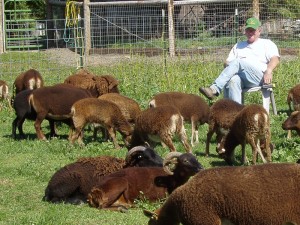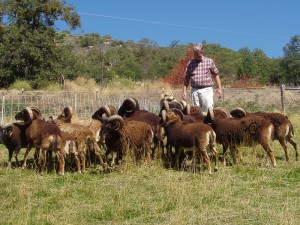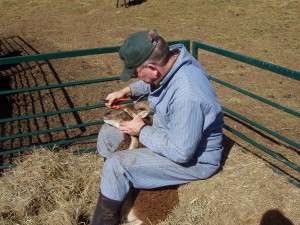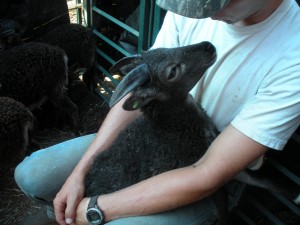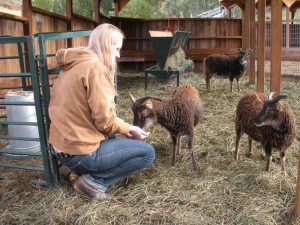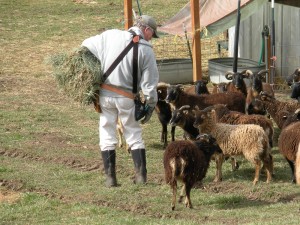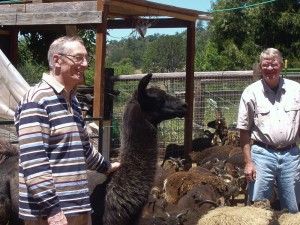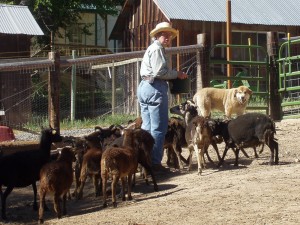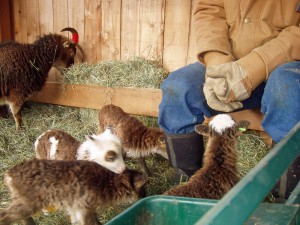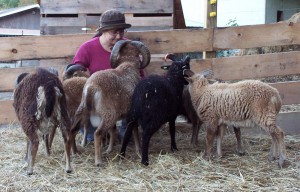The taming of the ewe, and of the ram
Where to put Soay rams and Soay ewes on the tame-to-wild spectrum seems to be this summer’s favorite question. Some folks are looking for docile sheep, some for sheep that will mimic life in the wild. Some breeders want to spend a lot of time with their animals, others want to simply watch the sheep from afar. The good news is you can shape your flock’s behavior, at least to some extent.
TAMING RAMS — BOTH A GOOD AND A BAD IDEA
Let’s start with intact rams, since they can present problems if not managed properly. There are just a few “thou shalt nots” but they matter.
First of all, if you have a male bottle baby, you should neuter him before he matures. Because he will have had hands-on contact with you for several weeks, he will assume you will continue to hold him, pet him, and even feed him whenever he asks for attention, even after he is full-grown and sexually mature. He will expect you to give him your undivided attention and may well turn on you if you turn your attention to your other rams or simply walk away. Wether him and he will be a mellow companion for your flock.
For the same reason, you should not train your ram lambs (much less the adults) to eat out of your hand or out of a bucket you are holding. If you do, they will want treats when you don’t have any and they will ram you, or at least give you a good whack with their heads. It may seem like “cute” behavior from a ram lamb, but it’s a risky habit to get them into.
Nor should you pet your ram lambs, even when they are little and cute. Pick them up only when you need to give them their Covexin shots or worm them or put in ear tags. Otherwise, do not handle them unless you plan to neuter them, and here’s why. Handling them creates the same issue as giving them treats or bottle feeding them: they will become accustomed to the attention and demand it even when you are not inclined to pet them, easy when they are little but a problem when they are full grown. And even though this may seem contradictory, if you pet them on the head, they will interpret your gesture as a head butt and they will likely return it in kind, especially during rut.
In sum, the risky interaction with a ram happens when the ram thinks he can come to you for hands-on attention — to be petted or scratched or hand-fed. If he does not get what he wants, he may become aggressive. It is just fine to feed by putting the hay or alfalfa in a feeder and then hanging around among the rams while they eat. And it’s just fine to walk among your rams; the more you do it, the more comfortable they will be when you need to round them up for hoof trims, vaccinations, and the like.
Bear with me a little longer on this issue, please; it is easy to do in practice but hard to describe in words. We certainly believe in having interaction with our rams, and lots of it, but not a “personal” relationship, not a petting or stroking or hand-feeding relationship. Except when we must actually handle our rams to care for them, we think shepherds should be part of the furniture or the equipment in the pasture or enclosure where the rams are and not try to touch them or make friends with them. We want our rams to think of us as benign apparatus temporarily located in their space. We are the feeders but we do not feed them directly. We are part of the infrastructure. We do not interact with them face to face by petting them or having close eye contact face to face. We want our rams to be accustomed to our presence and calm when we are with them, but we do not need to be “likable” or “friendly.” Ideally, they will ignore us most of the time, but also be ever so slightly fearful so that when we do need to touch and hold them for annual maintenance or injuries or disease, we can herd them (with Mollie the border collie’s help) or gather them ourselves without hurting the (injured) ram or exhausting ourselves chasing the animal.
In fact, in our experience, sheep generally do not want to be touched. They have a “comfort radius.” How big it is depends on how concerned they are that you will touch them. If you are doing something other than reaching for them, they will mill around us because they are used to having us in their space with them. But their comfort radius can quickly go to zero and the mellow mood evaporate if we grab one of them. Or if one of us trips, for example, the sheep will scatter for a few minutes. They do not like sudden movements of any kind.
At first we were surprised to learn that it often is easier to lead them into a space than to try to “push” them, even with Mollie’s help. This may seem counterintuitive, but it is consistent with the notion that they do not want us to “come after them.”
We occasionally hear stories about a “tame” ram who is just fine, behaves well, loves to be scratched on the head, and so forth. If you cannot resist trying to tame a ram, at least keep your guard up and always have your exit strategy in place for when he changes his mind!
In short, walk among your rams as often as possible while they are lambs and as they grow up, especially in whatever small areas they inhabit during parts of the day or overnight. Get them used to having you in with them, even though you are not petting or hand feeding them.
If your rams are accustomed to having you in their personal space, it will be much easier for you to calmly nudge them into whatever working pen area you put them in for things like the yearly hoof trim, checking for tight horns, giving them their annual Covexin booster, etc.
But wait a minute, what about the title of this post? What’s with the ewe business?
It should be enough of an answer to point out that limiting the title to “ram” would not have had the same Shakespearian ring to it, and it is summer theater season where we live, after all. More to the point, there is one area in which you should treat your ewes just like your rams with respect to taming them.
TAMING EWES — A GOOD IDEA
If you cannot avoid a ewe lamb bottle baby, she will have plenty of issues, but aggressiveness will not be among them. How I wish I had a picture of middle-aged Patterdale, our only bottle baby, still squeezing between our legs when we fill the hay feeders, knowing she can have the width of our legs to herself without competition from the bigger ewes. She’s done this ever since she was a lamb in among the adults as an orphan.
Similarly, you can train your ewes to eat out of your hand and it is a delightful interaction to encourage.
By all means walk among your ewes a lot, especially when they are pregnant. You will be handling them during lambing. The more comfortable they are with you before the lambs are imminent, the calmer and easier will be your interactions once the lambs arrive.
It is only in the area of petting the ewes that your behavior should mimic your relationship with the rams. It is just fine to handle your ewes a lot, pat them on their rumps, even tickle them under their chins. But avoid patting them on the tops of their heads. They will interpret the head tap just as rams do — as an opening head butt that they immediately return in kind. Thankfully I have no pictures to illustrate this point.
When should you start interacting with your lambs? As soon as the bond between the lamb and its mother is secure. We give our ewes and their lambs two or three days to bond in the jugs and then move them to a larger enclosure, the nursery. Note in this picture how calmly the ewe digs into the nursery hay while her lamb investigates Steve’s boots.
In closing, it is only fair to note that we did not invent the notion of acclimating our heritage Soay sheep — rams and ewes alike — to our presence. Several years ago we air shipped a handsome black ram to Shawn and Melissa Bramble. Here is Melissa nose to nose with her new ram and his new pasture buddies:
For now …
